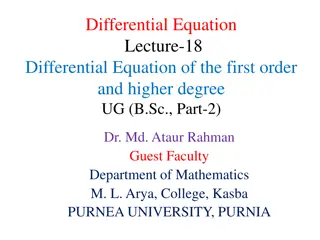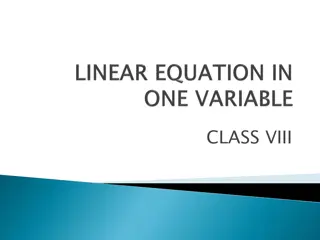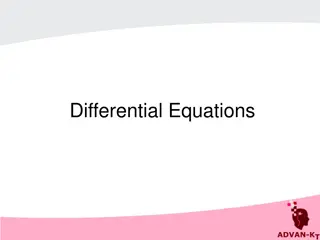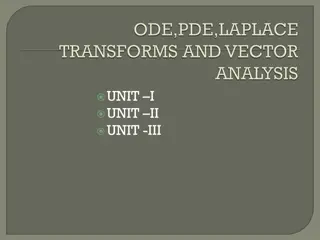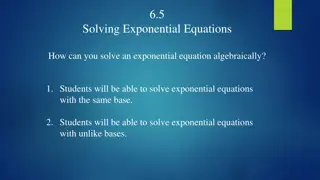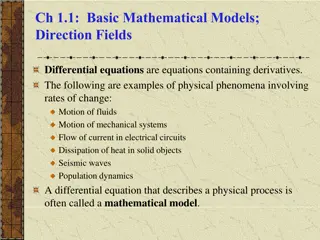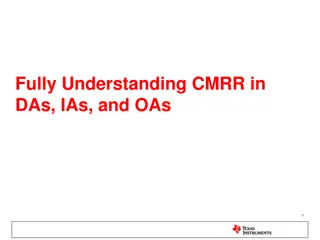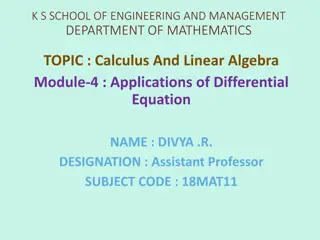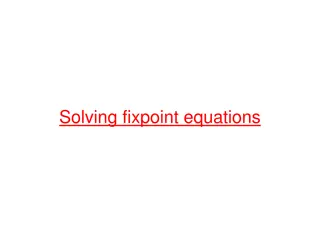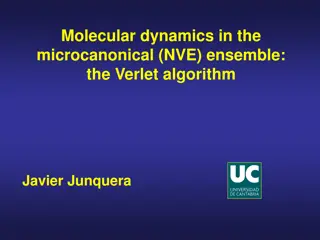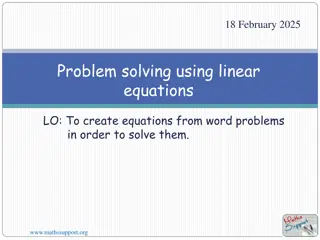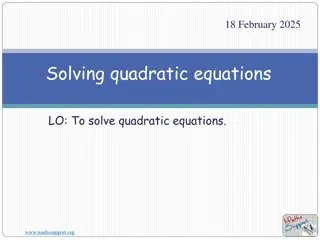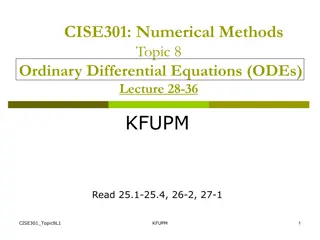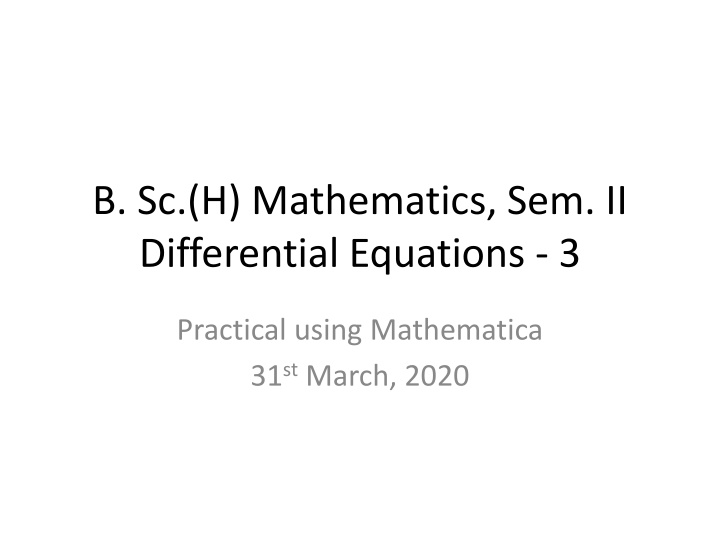
Practical Applications of Differential Equations in Mathematics
Explore practical examples such as Newton's Law of Cooling, Growth/Decay Models, Bacterial Growth, Radium Decay, and Lake Pollution Model using mathematical tools. Understand how differential equations are used to model real-world phenomena and solve complex problems.
Download Presentation

Please find below an Image/Link to download the presentation.
The content on the website is provided AS IS for your information and personal use only. It may not be sold, licensed, or shared on other websites without obtaining consent from the author. If you encounter any issues during the download, it is possible that the publisher has removed the file from their server.
You are allowed to download the files provided on this website for personal or commercial use, subject to the condition that they are used lawfully. All files are the property of their respective owners.
The content on the website is provided AS IS for your information and personal use only. It may not be sold, licensed, or shared on other websites without obtaining consent from the author.
E N D
Presentation Transcript
B. Sc.(H) Mathematics, Sem. II Differential Equations - 3 Practical using Mathematica 31stMarch, 2020
Newtons Law of Cooling T(t) temperature of a body as a function of time A temperature of the surrounding medium We have to find the rate of change of temperature w.r.t. time ?? ??= ? ? ? Where k is a positive constant We have to solve this differential equation using Mathematica Dsolve[T [t]==-k*(T[t] A), T, t ]
Growth/Decay Model ?? ??= ?? ?? ??= ?? Examples Population Growth Radioactive decay ? ?? ???????? ??? ????? ? ?? ???????? ??? ?????
A certain culture of bacteria grows at a rate proportional to the number present. It is found that the number doubles in 4 hours. a) How many bacteria may be expected at the end of 24 hours? b) Draw the graph of number of bacteria versus time Initially there are 2 bacteria and k = 1. Growth Model Given f[4] = 2 f[0], f[0] = c c e4k = 2 c e4k = 2 f[24] = c e24k = c [e4k]6 = c 26 = c 64 Bacteria grow 64 times in 24 hours
Radium decomposes at the rate proportional to the amount present. If the half the original amount disappears in 1600 years, find the percentage lost in 100 years. Given m[1600] = 1/2 f[0], f[0] = c c e-1600k = 1/2 c e-1600k = 1/2 f[100] = c e-100k = c [e-1600k]1/16 = c 2-1/16 Which is approx 96% of m , loss of 4 %
Lake Pollution model: Some Assumptions Lake has a constant volume V and is continuously well mixed so that the pollution is uniform throughout. C(t) is the concentration of the pollution in the lake at time t F is the rate at which water flows out of the lake in m3 /day Since the volume is constant flow of mixture into lake = flow of mixture out of lake = F Applying the balance law to the mass of the pollutant rate of change of mass of pollutant in lake = rate at which pollutant enters the lake - rate at which pollutant leaves the lake This leads to the diffrential equation ?? ??=? ???? ? ??
Lake Pollution Model S(t) = amount of salt in the tank at time t s0 : amount of salt dissolved in tank at t =0 cin(t): Concentration of the incoming mixture at time t Salt outflow Salt inflow Lake Rate of change of mass of salt in tank Rate of mass of salt that enters the tank mass of salt that leaves the tank Rate of salt entering the tank = Flow rate of water x cin(t) Rate of salt leaving the tank = (Flow rate of water ) x S(t)/(Amount of water in tank)
A large tank contains 100 liters of salt water. Initially s0 kg. of salt is dissolved. Salt water flows into the tank at the rate of 10 liters/min and the concentration cin(t) of the incoming water salt mixture varies with time. We assume Solution in the tank is thoroughly mixed and the salt solution flows out at the same rate as it inflows. Volume of the salt water mixture remains constant. Concentration = mass of salt per unit volume Diff equation for the amount of salt in the tank ?? ??= 10???? Solve this using Mathematica. 1 100? ? , ? 0 = ?0
Let cin(t) = 6 kg / liter S(0) = s0 = 5 kg Differential equation is ?? ??= 10.6 10 ?(?) 100
How long will it take for the lakes pollution level to reach 5 % of its initial level if only fresh water flows into the lake ?? ??=? C=0.05 c0 and cin = 0 ???? ? ??
General Compartmental Model Single Input and Output Tissues Drug Intake Digestion GI Tract Blood Application of balance law gives us two work equations, one for each compartment. Rate of change of drug in GI Tract Rate at which drug leaves GI Tract Rate of drug intake Rate at which drug leaves blood Rate of change of drug in blood Rate of drug intake
Model 1 Single Cold Pill x(t) = amount of drug in GI tract at time t y(t) = amount of drug in blood stream at time t Pill is swallowed and after that for sometime there is nothing entering the GI tract. This pill diffuses in the blood stream from GI tract. So for GI tract there is only an output term. Assume that output rate is proportional to GI tract drug concentration, which in turn is proportional to the amount of drug in the blood stream.
If x0 is the amount of drug in the pill and k1 is the constant of proportionality, then ?? ??= ?1? , y(0) = 0, as the initial amount of drug in the blood stream is 0. Further the level increases as drug diffuses from the GI tract and decreases as the kidneys and liver removes it. Thus ?? ??= ?1? ?2?, We have to solve these two equations (1) and (2). ? 0 = ?0 (1) ? 0 = 0 (2)
Suppose a single cold pill having 20 mg of drug is taken. The rate at which it diffuses in the GI tract is 1.3 mg/hr times the amount of drug . If the amount of drug leaving the blood stream is 0.13 mg/hr times the amount present in the blood stream. Find the amount of drug in the blood stream after 24 hours. For this problem k1 = 1.3 x0 = 20 k2 = 0.13 y0 = 0 To solve ?? ??= 1.3 ? , ?? ??= 1.3? 0.13?, ? 0 =20 ? 0 = 0
Solution using Mathematica or Amount of drug present in the blood stream after 24 hours is 0.98 mg
Model 2 A Course of Cold Pills In reality particularly for a cold , we take a course of pills rather than just a single pill so that there is a continuous flow of drug into the GI track. All the assumptions of the previous model hold except that we also assume that some amount of the drug remains indigested in the GI tract. Let a positive constant I represent the rate of indigestion of the drug. With slight modification in the model we get:
If x0 is the amount of drug in the pill and k1 is the constant of proportionality, then ?? ??= ? ?1? , y(0) = 0, as the initial amount of drog in the blood stream is 0. Further the level increases as drug diffuses from the GI tract and decreases as the kidneys and liver removes it. Thus ?? ??= ?1? ?2?, We have to solve these two equations (1) and (2). ? 0 = ?0 (1) ? 0 = 0 (2)


